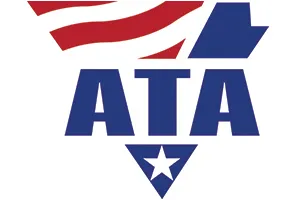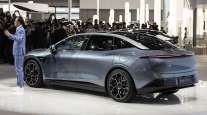Senior Reporter
Biden Administration Unveils EV Freight Charging Plan

[Stay on top of transportation news: Get TTNews in your inbox.]
A blueprint for establishing electric vehicle charging infrastructure for commercial trucks was recently announced by a multi-agency initiative.
As part of its continued push to decarbonize aspects of the freight sector, the Biden administration’s Joint Office of Energy and Transportation debuted its road map to gradually help reduce emissions through 2040.
The “National Zero-Emission Freight Corridor Strategy” is meant to inform budgets for agencies and facilitate public-private partnerships for stakeholders. Administration officials intend to rely on this new strategy to accelerate adoption of zero-emission Class 8 vehicles and other commercial trucks nationwide.
The aim is to develop a network of zero-emission charging infrastructure for medium- and heavy-duty trucks. A vast network of reliable EV charging stations and hydrogen fueling infrastructure is central to the administration’s goals.
“A core objective of the strategy is to meet freight truck and technology markets where they are today, determine where they are likely to develop next, and set an ambitious pathway that mobilizes actions to achieve decarbonization,” according to the 300-plus page plan the Joint Office of Energy and Transportation unveiled March 12. “The strategy identifies the greatest opportunities to support early introduction of [zero-emission medium- and heavy-duty vehicles], promoting cost savings for commercial fleets, cleaner air for communities, and strategic investments for infrastructure companies and electric utilities.”

A Tellus Power electric vehicle charger between a Volvo VNR electric truck, and a second-generation BYD 8TT electric semi-truck at Hight Logistics in Long Beach, Calif. (Bing Guan/Bloomberg)
Specific to the strategy is identifying ideal locations along freight corridors for such charging infrastructure. The initial set of freight hubs prioritized in the strategy include the Port Authority of New York and New Jersey, ports of Long Beach and Los Angeles, Port of San Diego, Port of Miami and Port Houston. Stretches of interstates 80, 95, 10 and 5 also are prioritized. The Federal Highway Administration designated the array of electric vehicle freight corridors and hubs.
“Medium- and heavy-duty trucks in our current freight network contribute approximately 23% of greenhouse gas emissions in the U.S. transportation sector,” FHWA Administrator Shailen Bhatt said March 12. “These new designations and strategy will help to grow our national [electric vehicle] charging network, encourage clean commerce within the freight community, and support President [Joe] Biden’s goals of achieving net-zero emissions for the nation by 2050.”
COMTO's April Rai offers tips to increase workforce diversity and grow profits.. Tune in above or by going to RoadSigns.ttnews.com.
The strategy is the culmination of a collaboration between the Environmental Protection Agency and the departments of Transportation and Energy. The strategy also is part of the administration’s big-picture emissions reduction initiative, which targets ports, other modes of transportation and multiple sectors. Relatedly, in the coming weeks, EPA is expected to announce new emissions standards for cars, trucks and heavy-duty vehicles.
“For over a century, petroleum-fueled freight has transported vital food and resources to American families, but at the same time, these vehicles have also contributed to lower public health, especially in densely populated communities,” Energy Secretary Jennifer Granholm said March 12.
“The Biden-Harris administration,” the secretary added, “is addressing this issue head-on with innovative strategies to transform freight so it not only supports American families and businesses but also protects the environment for future generations.”
Freight stakeholders and trucking firms welcomed the administration’s recent attention to their long-standing concerns associated with electric vehicles. For several years, commercial transportation groups have sounded the alarm over a lack of EV charging infrastructure for their industries.

“[American Trucking Associations] is encouraged that the Biden administration has begun to recognize the unique challenges electrification poses to the commercial vehicle industry,” ATA Vice President of Energy and Environmental Affairs Jacqueline Gelb said in a statement to Transport Topics. “Providing convenient and low-cost charging and hydrogen refueling infrastructure will be a key proof point for fleets to begin to adopt and operate zero-emission trucks. Establishing guidelines and parameters for a national freight network will prioritize federal activities and investment to deliver the necessary supporting infrastructure to ensure our nation’s supply chain can continue to deliver.”
Ritchie Huang, board treasurer of Powering America's Commercial Transportation, told TT: “The supply chain is critical to the advancement of the U.S. economy. It is imperative that PACT, government and all other relevant industry stakeholders work collaboratively to ensure rollout of ZEV infrastructure and M/HDVs is efficient and effective."
He added, “This strategy serves an important role in the planning and operations of these future corridors so that our supply chain is not only maintained but enhanced for zero emission." PACT members include Daimler, Navistar and Volvo.
Patrick Quinn, executive director of the Heavy-duty Leadership Group, observed the strategy “rightfully directs federal agencies to consider all available technology adoption and market dynamics while focusing on areas where the deployment of commercial zero-emission vehicles could be accelerated through public and private funding as well as the targeted buildout of essential infrastructure.
Want more news? Listen to today's daily briefing above or go here for more info
“The phased-in approach, which first focuses on critical hubs and then corridors, should result in realistic deployment expectations that can drive investment, job creation and U.S. technology leadership.”
The Heavy-duty Leadership Group includes BorgWarner, Cummins, Eaton and Ford.
On Capitol Hill, Sen. Alex Padilla (D-Calif.) praised the administration’s attention to this matter. “This landmark national strategy builds off California’s leadership and brings us one step closer to achieving a zero-emission transportation sector that provides clean air for communities, creates market certainty for industry and strengthens our supply chains,” he said.





